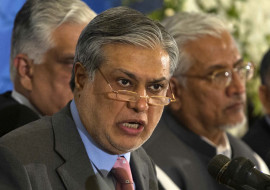
The growth rate was announced on Monday by the Pakistan Bureau of Statistics and is the first provisional reading of the growth in Gross Domestic Product (GDP) for the fiscal year that ends June 30. The number is subject to later revision, and is frequently revised significantly from its original projection.
The 4.2% growth rate was only marginally better than the 4.0% achieved last year, and well short of the government’s target of 5.1%. The International Monetary Fund, however, was projecting a 4.1% growth rate. While slower than the 7-8% that most macroeconomists believe is necessary to sustainably absorb new entrants into the workforce, it is nonetheless regarded as far more stable than the anemic 2.62% average growth rate during the preceding Zardari administration.
More than two-thirds of the growth – 68% to be precise – came from the services sector, the largest part of the economy and the one the government typically tends to ignore the most. Growth in agriculture and industry, where the government has the most intervention, grew slower.
Speaking to The Express Tribune on Sunday, Finance Minister Ishaq Dar acknowledged that the government needed to implement more growth-oriented reforms and that the Nawaz Administration was doing all it could to spur economic growth. All but five of the government’s targets were missed. The official GDP estimates for fiscal 2015 will be announced by the finance minister on June 4, with the release of the 2015 Economic Survey of Pakistan.
Out of 23 key growth indicators, the five hit the government’s targeted growth rates while 18 indicators, primarily in agriculture and industrial sectors, remained below expectations. And the provisional numbers may be telling an inflated story. As in previous years, the National Accounts Committee of the PBS took the budgeted numbers for development spending, whereas actual spending has lagged that number dramatically.

The budgetary estimates helped push government consumption and public investment up, which in turn pushed the overall growth rate to 4.2%.
Agriculture
The agriculture sector grew the slowest, increasing in size by only 2.9% as opposed to the 3.3% projected by the government. Agriculture accounts for 21.6% of GDP but only accounted for 14% of this growth. The anemic progress in agriculture is in line with the ruling Pakistan Muslim League Nawaz’s historical record of ignoring the sector that employs close to 37% of the labour force. During the PML-N’s two stints in office in the 1990s, agriculture grew by an average of 2.52% per year, as opposed to overall economic growth during that time averaging 4.06% per year.
Production of both major and minor crops, livestock and forestry remained below the government’s projected targets. Production of wheat and sugarcane, the two major crops where the government has the most intervention in the form of procurement programmes and support prices, was actually down compared to last year. So was production of maize. Only cotton ginning and fisheries grew by more than the government’s expectations.
Industries
The biggest miss from the government’s targets came in the industrial sector, which grew by 3.6% compared to the government’s 6.8% target, suggesting that a lack of access to credit, hampered because of heavy government borrowing crowding out the private sector, was causing a slowdown. The energy crisis, led by the state-owned portions of the energy supply chain, is also a factor that continues to hamstring industrial growth.
Every subsector – small-scale manufacturing, slaughtering, electricity generation and distribution, mining and quarrying, large scale manufacturing and construction – missed the government’s projections.
Services
The services sector, which accounts for more than half the economy, grew by 4.95%, narrowly missing the government’s 5.2% projected growth rate. Aided by heavy government borrowing and an increase in the money supply, the financial services sector and government services beat expectations, but every other subsector – transportation, communications, wholesale and retail – all missed targeted growth rates.
Published in The Express Tribune, May 19th, 2015.









































COMMENTS (6)
Comments are moderated and generally will be posted if they are on-topic and not abusive.
For more information, please see our Comments FAQ